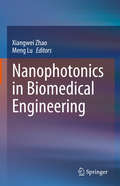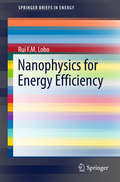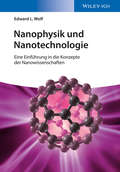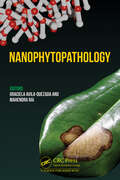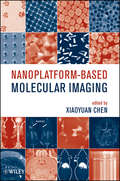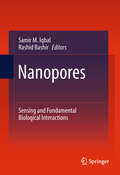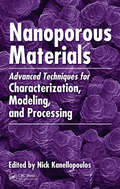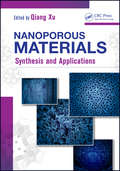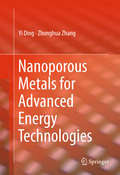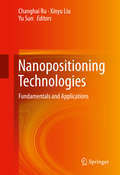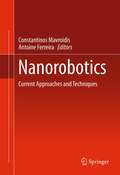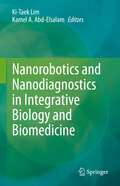- Table View
- List View
Nanophotonics and Plasmonics: An Integrated View (Series in Optics and Optoelectronics)
by Dr Ching Png Dr Yuriy AkimovThis book provides a first integrated view of nanophotonics and plasmonics, covering the use of dielectric, semiconductor, and metal nanostructures to manipulate light at the nanometer scale. The presentation highlights similarities and advantages, and shows the common underlying physics, targets, and methodologies used for different materials (optically transparent materials for nanophotonics, vs opaque materials for plasmonics). Ultimately, the goal is to provide a basis for developing a unified platform for both fields. In addition to the fundamentals and detailed theoretical background, the book showcases the main device applications. <P><P> Ching Eng (Jason) Png is Director of the Electronics and Photonics Department at the Institute of High Performance Computing, Agency for Science Technology and Research, Singapore. <P><P> Yuriy A. Akimov is a scientist in the Electronics and Photonics Department at the Institute of High Performance Computing, Agency for Science Technology and Research, Singapore.
Nanophotonics in Biomedical Engineering
by Meng Lu Xiangwei ZhaoThis book summarizes the latest advances in nanophotonics for biomedical applications, including biomolecular sensing and imaging, additive fabrications, and biophotonics. The engineering of nanophotonics will have significant impacts on the life sciences and medicine alike. Given its scope, the book offers a valuable asset for researchers, scientists, engineers, and graduate students in the fields of biomedical engineering, electrical engineering, materials sciences, optics, biology, and medicine.
Nanophotonics, Nanooptics, Nanobiotechnology, and Their Applications: Selected Proceedings of the 6th International Conference Nanotechnology and Nanomaterials (NANO2018), August 27-30, 2018, Kyiv, Ukraine (Springer Proceedings in Physics #222)
by Leonid Yatsenko Olena FesenkoThis book highlights some of the latest advances in nanotechnology and nanomaterials from leading researchers in Ukraine, Europe, and beyond. It features contributions from participants in the 6th International Science and Practice Conference Nanotechnology and Nanomaterials (NANO2018) in Kiev, Ukraine on August 27-30, 2018 organized by the Institute of Physics of the National Academy of Sciences of Ukraine, University of Tartu (Estonia), University of Turin (Italy), and Pierre and Marie Curie University (France). Internationally recognized experts from a wide range of universities and research institutions share their knowledge and key results on nanooptics, energy storage and biomedical applications. This book's companion volume also addresses topics such as materials properties, behavior, and synthesis.
Nanophysics and Nanotechnology: An Introduction to Modern Concepts in Nanoscience
by Edward L. WolfLong awaited new edition of this highly successful textbook, provides once more a unique introduction to the concepts, techniques and applications of nanoscale systems by covering its entire spectrum up to recent findings on graphene.
Nanophysics for Energy Efficiency
by Rui F. M. LoboThis book provides a succinct account of the ways in which nano technology is being applied to improve energy efficiency. The coverage includes current scanning probe techniques for electrical energy storage, energy harvesting systems and local electrochemistry as well as emerging techniques of relevance to diverse materials and devices, including advanced scanning probes for nano fabrication and nano tribology. The tools of nanotechnology, such as scanning probe microscopes and micro machines, can provide important information about the fundamental nature of space, especially the zero-point electromagnetic field. An exciting aspect of this subject is that a better understanding of the force that arises from the zero-point field, i. e. , the Casimir force, may enable its control to some extent, impacting on the development of nano electromechanical systems. Readers will find this book to be a clear and concise summary of the state of the art in nanophysics and nanotechnology as they relate to energy efficiency.
Nanophysics of Solar and Renewable Energy
by Edward L. WolfThis easy accessible textbook provides an overview of solar to electric energy conversion, followed by a detailed look at one aspect, namely photovoltaics, including the underlying principles and fabrication methods. Ed Wolf, an experienced author and teacher, reviews such green technologies as solar-heated-steam power, hydrogen, and thermoelectric generation, as well as nuclear fusion. Throughout the book, carefully chosen, up-to-date examples are used to illustrate important concepts and research tools. The opening chapters give a broad and exhaustive survey of long term energy resources, reviewing current and potential types of solar driven energy sources. The core part of the text on solar energy conversion discusses different concepts for generating electric power, followed by a profound presentation of the underlying semiconductor physics and rounded off by a look at efficiency and third-generation concepts. The concluding section offers a rough analysis of the economics relevant to the large-scale adoption of photovoltaic conversion with a discussion of such issues as durability, manufacturability and cost, as well as the importance of storage. The book is self-contained so as to be suitable for students with introductory calculus-based courses in physics, chemistry, or engineering. It introduces concepts in quantum mechanics, atomic and molecular physics, plus the solid state and semiconductor junction physics needed to attain a quantitative understanding of the current status of this field. With its comments on economic aspects, it is also a useful tool for those readers interested in a career in alternative energy.
Nanophysics, Nanomaterials, Interface Studies, and Applications
by Leonid Yatsenko Olena FesenkoThis book presents some of the latest achievements in nanotechnology and nanomaterials from leading researchers in Ukraine, Europe, and beyond. It features selected peer-reviewed contributions from participants in the 4th International Science and Practice Conference Nanotechnology and Nanomaterials (NANO2016) held in Lviv, Ukraine on August 24-27, 2016. The International Conference was organized jointly by the Institute of Physics of the National Academy of Sciences of Ukraine, Ivan Franko National University of Lviv (Ukraine), University of Tartu (Estonia), University of Turin (Italy), and Pierre and Marie Curie University (France). Internationally recognized experts from a wide range of universities and research institutions share their knowledge and key results on topics ranging from nanooptics, nanoplasmonics, and interface studies to energy storage and biomedical applications.
Nanophysics, Nanophotonics, Surface Studies, and Applications
by Leonid Yatsenko Olena FesenkoThis book presents some of the latest achievements in nanotechnology and nanomaterials from leading researchers in Ukraine, Europe, and beyond. It features contributions from participants in the 3rd International Science and Practice Conference Nanotechnology and Nanomaterials (NANO2015) held in Lviv, Ukraine on August 26-30, 2015. The International Conference was organized jointly by the Institute of Physics of the National Academy of Sciences of Ukraine, University of Tartu (Estonia), Ivan Franko National University of Lviv (Ukraine), University of Turin (Italy), Pierre and Marie Curie University (France), and European Profiles A. E. (Greece). Internationally recognized experts from a wide range of universities and research institutions share their knowledge and key results on topics ranging from nanooptics, nanoplasmonics, and interface studies to energy storage and biomedical applications.
Nanophysik und Nanotechnologie
by Edward L. WolfNoch hat das Motto "Alles muss kleiner werden" nicht an Faszination verloren. Physikern, Ingenieuren und Medizinern erschließt sich mit der Nanotechnologie eine neue Welt mit faszinierenden Anwendungen. E. L. Wolf, Physik-Professor in Brooklyn, N. Y. , schrieb das erste einführende Lehrbuch zu diesem Thema, in dem er die physikalischen Grundlagen ebenso wie die Anwendungsmöglichkeiten der Nanotechnologie diskutiert. Mittlerweile ist es in der 3. Auflage erschienen und liegt jetzt endlich auch auf Deutsch vor. Dieses Lehrbuch bietet eine einzigartige, in sich geschlossene Einführung in die physikalischen Grundlagen und Konzepte der Nanowissenschaften sowie Anwendungen von Nanosystemen. Das Themenspektrum reicht von Nanosystemen über Quanteneffekte und sich selbst organisierende Strukturen bis hin zu Rastersondenmethoden. Besonders die Vorstellung von Nanomaschinen für medizinische Anwendungen ist faszinierend, wenn auch bislang noch nicht praktisch umgesetzt. Der dritten Auflage, auf der diese Übersetzung beruht, wurde ein neuer Abschnitt über Graphen zugefügt. Die Diskussion möglicher Anwendungen in der Energietechnik, Nanoelektronik und Medizin wurde auf neuesten Stand gebracht und wieder aktuelle Beispiele herangezogen, um wichtige Konzepte und Forschungsinstrumente zu illustrieren. Der Autor führt mit diesem Lehrbuch Studenten der Physik, Chemie sowie Ingenieurwissenschaften von den Grundlagen bis auf den Stand der aktuellen Forschung. Die leicht zu lesende Einführung in dieses faszinierende Forschungsgebie ist geeignet für fortgeschrittene Bachelor- und Masterstudenten mit Vorkenntnissen in Physik und Chemie. "Zusammenfassend ist festzustellen, dass Edward L. Wolf trotz der reichlich vorhandenen Literatur zur Nanotechnologie ein individuell gestaltetes einführendes Lehrbuch gelungen ist. Es eignet sich - nicht zuletzt dank der enthaltenen Übungsaufgaben - bestens zur Vorlesungsbegleitung für Studierende der Natur- und Ingenieurwissenschaften sowie auch spezieller nanotechnologisch orientierter Studiengänge. " Physik Journal ". . . eine sehr kompakte, lesenswerte und gut verständliche Einführung in die Quantenmechanik sowie ihre Auswirkungen auf die Materialwissenschaften. . . " Chemie Ingenieur Technik
Nanophytopathology
by Mahendra Rai Graciela Avila-QuezadaThe book entitled ‘Nanophytopathology’ discusses the need for alternative technologies particularly smart nanotechnological tools including nanobiosensor in the detection of plant diseases, delivery of fungicides/pesticides, and therapy for the diseases caused by plant pathogens and pests. The use of nanomaterials will minimize the huge amount of application of pesticides and fungicides thereby reducing environmental pollution. This technology is eco-friendly, economically viable, and useful for sustainable crop production. The book encompasses chapters written by experienced experts in respective fields, which provide up-to-date knowledge about pathogen/pest control using nanotechnology. It will be essential reading for post-graduate students and researchers, agriculture scientists, nanotechnologists, microbiologists, green chemistry experts, and biotechnologists.
Nanoplasmonic Sensors
by Alexandre DmitrievThis book is a compendium of the finest research in nanoplasmonic sensing done around the world in the last decade. It describes basic theoretical considerations of nanoplasmons in the dielectric environment, gives examples of the multitude of applications of nanoplasmonics in biomedical and chemical sensing, and provides an overview of future trends in optical and non-optical nanoplasmonic sensing. Specifically, readers are guided through both the fundamentals and the latest research in the two major fields nanoplasmonic sensing is applied to - bio- and chemo-sensing - then given the state-of-the-art recipes used in nanoplasmonic sensing research.
Nanoplasmonics, Nano-Optics, Nanocomposites, and Surface Studies
by Leonid Yatsenko Olena FesenkoThis book highlights the most recent advances in nano science from leading researchers in Ukraine, Europe and beyond. It features contributions from participants of the 3rd International Summer School "Nanotechnology: From Fundamental Research to Innovations," held in Yaremche, Ukraine on August 23-26, 2014 and of the 2nd International NANO-2014 Conference, held in Lviv, Ukraine on August 27-30, 2014. These events took place within the framework of the European Commission FP7 project Nano twinning and were organized jointly by the Institute of Physics of the National Academy of Sciences of Ukraine, University of Tartu (Estonia), University of Turin (Italy) and Pierre and Marie Curie University (France). Internationally recognized experts from a wide range of universities and research institutions share their knowledge and key results in the areas of nanocomposites and nanomaterials, nanostructured surfaces, microscopy of nano-objects, nano-optics and nano photonics, nano plasmonics, nano chemistry, nano biotechnology and surface enhanced spectroscopy. Covers nanocomposites, nano structured surfaces and nano biotechnology Presents state-of-the-art advances in nano plasmonics, nanomaterials characterization and surface enhanced spectroscopy Represents essential reading for advanced undergraduate and graduate students through practicing university and industry researchers
Nanoplasmonics: Advanced Device Applications (Devices, Circuits, and Systems)
by Krzysztof Iniewski James W. M. ChonFocusing on control and manipulation of plasmons at nanometer dimensions, nanoplasmonics combines the strength of electronics and photonics, and is predicted to replace existing integrated circuits and photonic devices. It is one of the fastest growing fields of science, with applications in telecommunication, consumer electronics, data storage, medical diagnostics, and energy. Nanoplasmonics: Advanced Device Applications provides a scientific and technological background of a particular nanoplasmonic application and outlines the progress and challenges of the application. It reviews the latest developments in nanoplasmonic applications, such as optical storage, photovoltaics, photocatalysts, integrated chips, optical elements, and sensing. The areas of application were chosen for their practicality, and each chapter provides a balanced scientific review and technological progress of how these areas of application are shaping the future.
Nanoplatform-Based Molecular Imaging
by Xiaoyuan ChenThe cutting-edge guide on advancing the science of molecular imaging using nanoparticlesNanoplathform-Based Molecular Imaging provides rationale for using nanoparticle-based probes for molecular imaging, then discusses general strategies for this underutilized, yet promising, technology. It addresses general strategies of particle synthesis and surface chemistry, applications in computed tomography optical imaging, magnetic resonance imaging, ultrasound, multimodality imaging, theranostics, and finally, the clinical perspectives of nanoimaging. This comprehensive volume summarizes the opinions of those in the forefront of research and describes the latest developments by emphasizing fundamentals and initiating hands-on application.
Nanopore-Based Technology
by Maria E. GrachevaNanopores are vital biological features, described as tiny holes in cellular membranes used for recognition and transport of ions and molecules between compartments within the cell, as well as between the extracellular environment and the cell itself. Their study, ever growing in esteem, leads toward the promise of ultra-fast sequencing of DNA molecules with the ultimate goal of building a nanoscale device that will make rapid and cheap DNA sequencing a reality. In Nanopore-Based Technology, expert researchers in the forefront of the field explore the cutting-edge of nanopore technology for single molecule sensing, detection, and characterization. Divided into four convenient parts, this volume covers single molecule characterization techniques utilizing biological pores, methods for biomolecule characterization with nanoporous artificial membranes, computational studies of the biomolecule confined within the nanopore environment, as well as techniques that use novel materials in conjunction with nanopore sensing. Written for the highly successful Methods in Molecular BiologyTM series, this work provides the kind of detailed description and implementation advice that is crucial for achieving optimal results. Authoritative and state-of-the-art, Nanopore-Based Technology serves as an excellent representation of the present-day available techniques for biomolecule characterization with nanoporous membranes in order to guide researchers toward developing the next generation of technologies for fast and cheap DNA sequencing with practically no limitations on the read lengths.
Nanopores
by Rashid Bashir Samir M. IqbalNanopores are nanometer scale holes formed naturally by proteins or cells, and can be used for a variety of applications, including sequencing DNA and detecting anthrax. They can be integrated into artificially constructed encapsulated cells of silicon wafers while allowing small molecules like oxygen, glucose and insulin to pass, while keeping out large system molecules. "Nanopores: Sensing and Fundamental Biological Interactions" examines the emerging research directions surrounding nanopores such as genome sequencing and early disease detection using biomarker identification. Covering the applications of nanopores in genetics, proteomics, drug discovery, early disease detection and detection of emerging environmental threats, it is a must-have book for biomedicalengineers and research scientists.
Nanoporous Alumina
by Dusan Losic Abel SantosThis book gives detailed information about the fabrication, properties and applications of nanoporous alumina. Nanoporous anodic alumina prepared by low-cost, simple and scalable electrochemical anodization process due to its unique structure and properties have attracted several thousand publications across many disciplines including nanotechnology, materials science, engineering, optics, electronics and medicine. The book incorporates several themes starting from the understanding fundamental principles of the formation nanopores and theoretical models of the pore growth. The book then focuses on describing soft and hard modification techniques for surface and structural modification of pore structures to tailor specific sensing, transport and optical properties of nano porous alumina required for diverse applications. These broad applications including optical biosensing, electrochemical DNA biosensing, molecular separation, optofluidics and drug delivery are reviewed in separated book chapters. The book appeals to researchers, industry professionals and high-level students.
Nanoporous Carbons for Soft and Flexible Energy Devices (Carbon Materials: Chemistry and Physics #11)
by Francesca Borghi Francesca Soavi Paolo MilaniThis book provides an interesting snapshot of new research within the fields of flexible and soft devices which use porous carbon-based materials. The increase in demand for soft and flexible electronics, electrochemical energy storage/conversion systems, piezoresistive pressure sensors has promoted the development of new strategies for the synthesis and integration of nanoporous carbon (NPC) into flexible and soft polymers and inorganic textures. The structural properties of such NPC materials combined with their mechanical, conductive and catalytic properties, show promising results for the technology they are designed for, which can be useful solutions in many other disciplines. An in-depth discussion of the use of NPC materials in different energy devices is provided in every chapter, while at the same time the knowledge of the reader on the various applications where these materials can be used will be broadened. This book sheds new light on nanoporous carbon-based materials and will be of great interest to graduate students and professionals working in this field.
Nanoporous Materials: Advanced Techniques for Characterization, Modeling, and Processing
by Nick KanellopoulosHaving successfully replaced elements used in traditional, pollution-prone, energy-consuming separation processes, nanoporous materials play an important role in chemical processing. Although their unique structural or surface physicochemical properties can, to an extent, be tailored to meet specific process-related requirements, the task of charac
Nanoporous Materials: Synthesis and Applications
by Qiang XuIn the past two decades, the field of nanoporous materials has undergone significant developments. As these materials possess high specific surface areas, well-defined pore sizes, and functional sites, they show a great diversity of applications such as molecular adsorption/storage and separation, sensing, catalysis, energy storage and conversion,
Nanoporous Metals for Advanced Energy Technologies
by Yi Ding Zhonghua ZhangThis book covers the state-of-the-art research in nanoporous metals for potential applications in advanced energy fields, including proton exchange membrane fuel cells, Li batteries (Li ion, Li-S, and Li-O2), and supercapacitors. The related structural design and performance of nanoporous metals as well as possible mechanisms and challenges are fully addressed. The formation mechanisms of nanoporous metals during dealloying, the microstructures of nanoporous metals and characterization methods, as well as miscrostructural regulation of nanoporous metals through alloy design of precursors and surface diffusion control are also covered in detail. This is an ideal book for researchers, engineers, graduate students, and government/industry officers who are in charge of R&D investments and strategy related to energy technologies.
Nanopositioning Technologies
by Yu Sun Xinyu Liu Changhai RuThis book covers the state-of-the-art technologies for positioning with nanometer resolutions and accuracies, particularly those based on piezoelectric actuators and MEMS actuators. The latest advances are described, including the design of nanopositioning devices, sensing and actuation technologies and control methods for nanopositioning. This is an ideal book for mechanical and electrical engineering students and researchers; micro and nanotechnology researchers and graduate students; as well as those working in the precision instrumentation or semiconductor industries.
Nanorobotics
by Constantinos Mavroidis Antoine FerreiraNanorobots can be defined as intelligent systems with overall dimensions at or below the micrometer range that are made of assemblies of nanoscale components with individual dimensions ranging between 1 to 100 nm. These devices can now perform a wide variety of tasks at the nanoscale in a wide variety of fields including but not limited to fields such as manufacturing, medicine, supply chain, biology, and aerospace. Nanorobotics: Current Approaches and Techniques offers a comprehensive overview of this emerging interdisciplinary field with a wide ranging discussion that includes nano-manipulation and industrial nanorobotics, nanorobotic manipulation in biology and medicine, nanorobotic sensing, navigation and swarm behavior and CNT, and protein and DNA-based nanorobotics.
Nanorobotics and Nanodiagnostics in Integrative Biology and Biomedicine
by Kamel A. Abd-Elsalam Ki-Taek LimNanorobotics and Nanodiagnostics in Integrative Biology and Biomedicine "Nanorobotics and nanodiagnostics” can be defined as a new generation of biohybrid and nanorobotics that translate fundamental biological principles into engineering design rules, or integrative living components into synthetic structures to create biorobots and nanodiagnotics that perform like natural systems. Nanorobots or nanobots are structured of a nanoscale made of individual assemblies. They can be termed as intelligent systems manufactured with self-assembly strategies by chemical, physical and biological approaches. The nanorobot can determine the structure and enhance the adaptability to the environment in interdisciplinary tasks."Nanorobotics and nanodiagnostics" is a new generation of biohybrid that translates fundamental biological principles into engineering design rules to create biorobots that perform like natural systems. These biorobotics and diagnostics can now perform various missions to be accomplished certain tasks in the research areas such as integrative biology and biomedicine. "Nanorobotics and Nanodiagnostics in Integrative Biology and Biomedicine" sheds light on a comprehensive overview of the multidisciplinary areas that explore nanotherapeutics and nanorobotic manipulation in biology and medicine. It provides up-to-date knowledge of the promising fields of integrative biology and biomedicine for nano-assisted biorobotics and diagnostics to detect and treat diseases that will enable new scientific discoveries.
Nanosatellites: Space and Ground Technologies, Operations and Economics
by Jaime Estela Martin Langer Rogerio Atem de CarvalhoNanosatellites: Space and Ground Technologies, Operations and Economics Rogerio Atem de Carvalho, Instituto Federal Fluminense, Brazil Jaime Estela, Spectrum Aerospace Group, Germany and Peru Martin Langer, Technical University of Munich, Germany Covering the latest research on nanosatellites Nanosatellites: Space and Ground Technologies, Operations and Economics comprehensively presents the latest research on the fast-developing area of nanosatellites. Divided into three distinct sections, the book begins with a brief history of nanosatellites and introduces nanosatellites technologies and payloads, also explaining how these are deployed into space. The second section provides an overview of the ground segment and operations, and the third section focuses on the regulations, policies, economics, and future trends. Key features: Payloads for nanosatellites Nanosatellites components design Examines the cost of development of nanosatellites. Covers the latest policies and regulations. Considers future trends for nanosatellites. Nanosatellites: Space and Ground Technologies, Operations and Economics is a comprehensive reference for researchers and practitioners working with nanosatellites in the aerospace industry.

